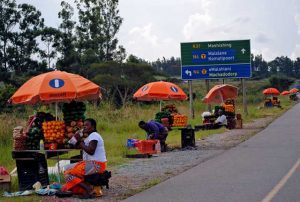Prioritising Pedestrians and Cyclists when Building Roads
July 7, 2017
Publication: Infrastructure News
Author: Riante Naidoo
Vendors on the roadside often commute on foot to and from their places of work.
The message of prioritising pedestrians and cyclists when planning, designing and implementing road infrastructure, took centre stage at a recent South African Road Federation seminar.
The seminar was in partnership with the South African National Roads Agency (Sanral).
The agency’s provincial coordinator and SARF national road safety chairperson, Gail Bester, said that over the decades, the industry has made significant strides in designing infrastructure that is faster, wider and more efficient for motorised transport, while non-motorised transport has not received the focus it deserves. “It cannot be treated as an add-on at the risk of being ad hoc and fragmented,” she said.
As a result, the SARF road safety committee saw the need to host its first seminar dedicated to promoting the non-motorised transport agenda.
Non-motorised transport
Non-motorised modes of transport remain a big reality in South Africa. According to the National Household Travel Survey, 2.9 million workers walk from their homes to work, and 12.7 learners commute on foot to school daily.
However, pedestrians remain the most vulnerable road users and account for almost half (1,456 of the 3,904) of the road fatalities, as recorded by the Road Traffic Management Corporation, between October and December 2016.
“The fact that motor vehicles have been the dominant mode of transport in road designs is apparent in the high crash fatalities involving pedestrians,” Bester said. “It was therefore necessary that we initiated dialogue amongst us as industry professionals to mainstream non-motorised transport considerations in the planning, design and implementation of road infrastructure.
“This is aligned with the resolutions of the National Road Safety Strategy, the vision of the United Nations Decade of Action, and the recently formalised non-motorised transport guidelines developed by the National Department of Transport,” she added.
Pedestrian and public transport guidelines
Sanral project manager Siveshni Pillay was one of 11 speakers at the seminar. She delivered a presentation focused on the recently developed draft pedestrian and public transport facility guidelines document for national roads.
Pillay explained that historically, Sanral managed mainly high mobility corridors including freeways. Since taking over additional routes from provinces, which have substantial public transport and pedestrian activities and facilities, Sanral said it had to manage the balance between freeway mobility, public transport and the accommodation of pedestrians.
“Sanral’s guidelines provide guidance to designers and decision makers on design principles for the development of an integrated roadway that ensures the safety and mobility of all road users,” Pillay said.
The guidelines draw on lessons learnt on the routes taken over by agency such as the R573 Moloto Road from Gauteng to Mpumalanga and Limpopo, R71 in Limpopo and R61 in the Eastern Cape.
Engineering solutions took into account rural settlements and schools along these routes, as well as informal trading on the road reserve which add to the number of pedestrians on national roads.
Pillay said that presented on a public platform for the first time, the guidelines will be piloted to test the practicalities and workability of some of the proposed solutions. “The guidelines will also be shared with industry players for comment,” Sanral said.
Bester concluded her address by saying the federation was committed to rolling out similar seminars nationally as it was time to “transform our space, change our thinking and promote the non-motorised transport agenda

